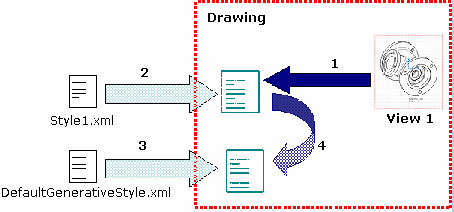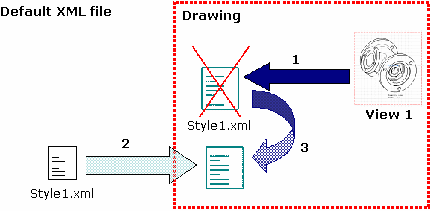About Generative View Styles | ||
| ||
General Information
Administrators can create one or several generative view styles from which users can choose when creating a generative view.
Generative view styles are defined in an XML file.
| Important: Some workbenches (such as Structure Functional Design or Generative Shape Design) also offer the possibility of configuring generative view styles. These styles will be specific to views generated from this workbench, and will specify the appearance of the geometry to be generated. To know if a given workbench supports generative view styles, either refer to its documentation or to Setting General Generative View Style Parameters. |
![]()
Structure of Generative View Styles
The DefaultGenerativeStyle.xml file is available in the Standard Definition dialog box (via Tools > Standards > generativeparameters category).
This file is structured as a tree. Under the Standard > DefaultGenerativeStyle nodes, there are several sub-nodes:
- the Drafting node is devoted to customizing generative view styles for views generated from any 3D workbench in general. For more information, refer to Setting General Generative View Style Parameters.
- the other nodes are devoted to customizing generative view styles for views generated from given workbenches. For example, the SheetMetal node is devoted to customizing generative view styles for views generated from the Generative SheetMetal Design workbench. For more information, refer to Setting Workbench-Specific Generative View Style Parameters and/or to the workbench's User's Guide.
![]()
Management of Generative View Styles
You can manage generative view styles by creating one generative view style per view, controlling its access and modification and so on.
One generative view style per view
When you create a view using a generative view style, you specify the XML file that will be associated with this view. Within a drawing/layout, you can only associate one generative view style to a given view, but you can use several generative view style files by associating different files to different views.
Standalone drawings
The values of the parameters in the specified XML file are embedded into the CATDrawing/layout document when a generative view style is applied to a view. Each drawing/layout contains an embedded copy of the generative view style(s) it uses. The drawing is therefore standalone. This makes it possible for users, projects, or companies to exchange CATDrawing/layout documents without needing to send the generative view style file along.
Administrator-controlled access and modification
The Administering Standards and Generative View Styles the location of the generative view style files as well as the ability to modify existing ones. For example, the administrator can define a single generative view style, and prevent users from modifying it.
Administrator-controlled authorized styles
The administrator defines the list of authorized generative view styles, in the Drafting standards XML file.
A generative view style file available by default
By default, a pre-defined generative view style file is delivered. This file is located in install_root/resources/standard/generativeparameters /DefaultGenerativeStyle.xml.
Administrators can customize this file to define their default generative view styles. They can also use this file as a template for creating new generative view styles.
They can add as many generative view style files as needed. Refer to Administering Standards and Generative View Styles for more information.
| Important: Do not delete the DefaultGenerativeStyle.xml file: it contains all generative view style parameters. Furthermore, it is used as a default if a parameter happens to be missing from a custom view style file (in this case, the corresponding parameter defined in DefaultGenerativeStyle.xml will be used instead). In case the DefaultGenerativeStyle.xml file cannot be found, then the application will use its own default parameter instead. |
Editing the generative view style file
The generative view style files can be edited using an interactive editor. This editor provides an easy-to-use graphic interface to let you customize the parameters included in the generative view style file. For information on how to customize the parameters included in the generative view style file, refer to Setting General Generative View Style Parameters.
The interactive editor is available in Tools > Standards. (It is the same editor with which you can customize the Drafting standards). For more information on how to use this editor, refer to the Customizing Standards chapter in the Infrastructure User's Guide.
| Important: Make sure you use the Standards editor available in Tools > Standards when modifying and customizing the XML generative view style files. Using other editors (such as text editors) may alter the consistency of the generative view style XML files, and may make them unusable. |
Update of a newer version of a generative view style file
Once a generative view style has been assigned to a view, it is embedded into the drawing/layout. This means that if you update the generative view style file that was used to create the view, the style of the view itself will not be modified and will remain as it was when the view was created.
To modify the style used by the view, you need to update the newer version of the generative view style XML file into the drawing/layout. To do so, select Tools > Generative View Styles... In the dialog box which is displayed, select the generative view style to update and click Update.
Note the following points:
- The newer generative view style will completely override the older version of the generative view style in all views which use this generative view style.
- If the drawing/layout contains views which use other generative view styles, these views will not be affected by the import.
Updating a newer version of a given generative view style file will be useful to ensure that views created on a previous release using the generative view styles provided by default with the application benefit from the new styles parameters that were added in the latest release.
To sum-up
For the purpose of this scenario, create a drawing view with a generative view style according to the following procedure:
-
Create View 1 using the generative view style defined in Style1.xml.
-
As a consequence, Style1.xml is embedded into the drawing.
-
Then, when a given parameter cannot be retrieved from Style1.xml, DefaultGenerativestyle.xml is embedded into the drawing.
-
Finally, the missing parameter is retrieved from DefaultGenerativestyle.xml.
| Important: If a given parameter cannot be retrieved from the default xml file, a pre-defined and non modifiable value is used instead. |

Update of a generative view file is as follows:
-
View 1 has been created using the generative view style defined in Style1.xml that was embedded into the drawing.
-
Update the current Style1.xml file with the latest version of the external Style1.xml file and the current xml file is overridden.
-
As a consequence View1 refers to updated Style1.xml.

![]()
Use of Generative View Styles
The information in this section is presented in a Generative Drafting context, but you can use generative view styles in a 2D Layout for 3D Design context by opening a layout representation, selecting a view and changing its generation properties. Refer to 2D Layout for 3D Design User's Guide: Generation Tab, for more information.
Create views using generative view styles
When generating a view from the 3D, users can choose to use one of the styles defined by the administrator. Refer to Generative Drafting User's Guide: Working with Generative View Style: Creating a View using Generative View Styles.
Switch a view to another generative view style
Once a view has been created using a specific generative view style, it is possible to switch this view to another view style. Refer to Generative Drafting User's Guide: Working with Generative View Style: Switching a View to Another Generative View Style.